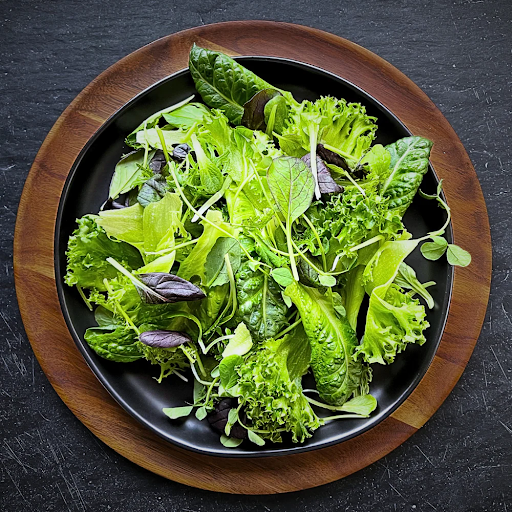
This summer, we did a side-by-side comparison of the greens that compose the salads that fuel Detroit: hydroponic and farm-grown lettuce. As a farm rooted in the city, we’re always curious about how our produce stacks up.
At Planted Detroit, we compared the taste, the texture, the visual appearance, the nutrition, and the sustainability, asking one simple question: what’s the difference? From our research, the answer lies in the details and the freshness.
If you have never had hydroponic lettuce, this blog explains why it isn’t just a way of growing, it’s a movement. Let’s dig in.
What Is Hydroponic Lettuce?
Hydroponically grown lettuce is grown with no soil. Yes, you read that right.
And to take that a step further, instead of outdoor growing, we are harvesting indoors, using a controlled water-based system to deliver nutrients to the plant roots. At Planted Detroit, we push the innovation envelope even further by growing vertically, using stacked growing beds in climate-controlled rooms lit by LEDs mimicking natural sunlight.
This ensures absolutely no runoff, no pests chewing on the leaves as they grow, and no unforeseen weather events such as a thunderstorm blowing in, which can happen when you are growing outdoors.
Hydroponic farming isn't just about control; it is also about the efficiency of reducing water consumption by 90% when compared to traditional agriculture. It also eliminates harmful pesticides.
As a result, we produce clean, vibrant lettuce that goes from farm to plate in the blink of an eye.
How Does Field-Grown Lettuce Stack Up?
Field-grown lettuce is what most of us have grown up eating.
These greens, grown in open soil, rely upon natural growing practices through sunlight, rain, seasons, and everything else that is out there. They are also subjected to wind, pests, and sometimes chemical inputs like fertilizers and pesticides to ensure growth and prevent diseases.
There’s something very traditional about field-grown lettuce. It is relatable and accustomed to large-scale growing approaches, and we have a certain level of comfort regarding this traditionally farmed lettuce.
Field-grown lettuce has trade-offs. The growing area, including the soil, may be contaminated. The farming cycle is seasonal, which means that variability of weather may also affect quality and availability. And because field-grown lettuce is traditionally harvested and washed, there’s a greater chance of bruising, spoilage, and food waste.

Now, the question remains about which one is the better lettuce. To conclude the research, we performed tests.
Detroit Summer Taste Test: The Freshness Showdown
We harvested a few heads of hydroponically grown lettuce from our farm and purchased some freshly harvested field greens from a nearby farmers' market. We then sat down for a real side-by-side sensory comparison of the two greens; no oil, no dressing, no distractions.
Here’s how they compared:
-
Texture: Hydroponic lettuce was crunchy, thick, and full of snap. The leaves held up beautifully after being out of refrigeration for a couple of hours. Field lettuce was still fresh, but the texture was slightly less firm, and it wilted more quickly once pulled from refrigeration.
-
Flavor: Hydroponic lettuce had a light, clean, subtly sweet flavor; there was no bitterness and no ‘earthy’ aftertaste. It tasted fresh in a way that is difficult to explain unless you have tasted it yourself. Field lettuce was slightly more pungent and had a subtle bitter aftertaste. It was a bit grassy, depending on the type.
-
Appearance: Planted Detroit’s hydroponic lettuce was practically perfect: round and green, without any soil. The field lettuce was perfect too, just differently beautiful. It was rustic, with jagged edges and some blemishes, just as it should be. While they ask us not to judge a book by its cover, if you are a visual eater, the hydroponic lettuce will feel a little more ‘ready-for-you’ in comparison.
-
Shelf Life: Herein lies hydroponic lettuce’s biggest strength. Because we harvest, package, and deliver in such a short span of time, Planted's greens arrive at your doorstep just hours after leaving the farm. Seasonal field-grown lettuce, based on the supply chain, can be several days post-harvest before it even reaches your fridge.
Are you ready to do your own taste test? Check out our seasonal salad bundles, packed with fresh-harvested hydroponic greens, delivered right to your door.
Nutrition and Clean Growing: What the Research Says

Nutritionally speaking, hydroponic lettuce acts as an equal to, if not better than, field-grown lettuce. It is harvested and consumed quickly, which delivers delicate nutrients, including Vitamin C and folate, that can be protected far better than greens that travel long distances.
Studies have found that hydroponically grown greens often have greater amounts of antioxidant activity and nutrient content than soil-grown greens.
Hydroponic systems also remove exposure to soil contaminants, pesticides, and heavy metals, providing cleaner, healthier greens while offering the same taste and nutrition.
For families, schools, and health-conscious eaters, hydroponics provides peace of mind along with a plate full of greens.
Sustainability Snapshot: Why Hydroponics Matter in Urban Farming
Hydroponics isn't just a cool way to grow lettuce; it's a smarter way to feed people in cities.
At Planted Detroit, our hydroponic process uses 90% less water than traditional farming. We grow everything locally, which means fewer trucks on the road, fewer food miles, and a dramatically lower carbon footprint.
Plus, we grow year-round in a controlled environment, allowing us to avoid pesticides or fertilizers and still consistently produce a harvest every week.
For food access and environmental resilience, hydroponics offers a hopeful vision of the future in a city like Detroit: fresh foods grown by and for the community.
So, Which Lettuce Wins? (Spoiler: You Do)
Hydroponically grown lettuce and field-grown lettuce can coexist. However, when it comes to freshness, safety, sustainability, and shelf life, hydroponic lettuce wins, especially when it is grown in the city.
In under 24 hours, it travels from farm to fridge, and you can acquire freshness that you can taste. Additionally, it lasts longer and causes less wastage.
Ready to try hydroponic greens? Get a Salad Bundle from Planted Detroit or order through Market Wagon to have it delivered locally today!
